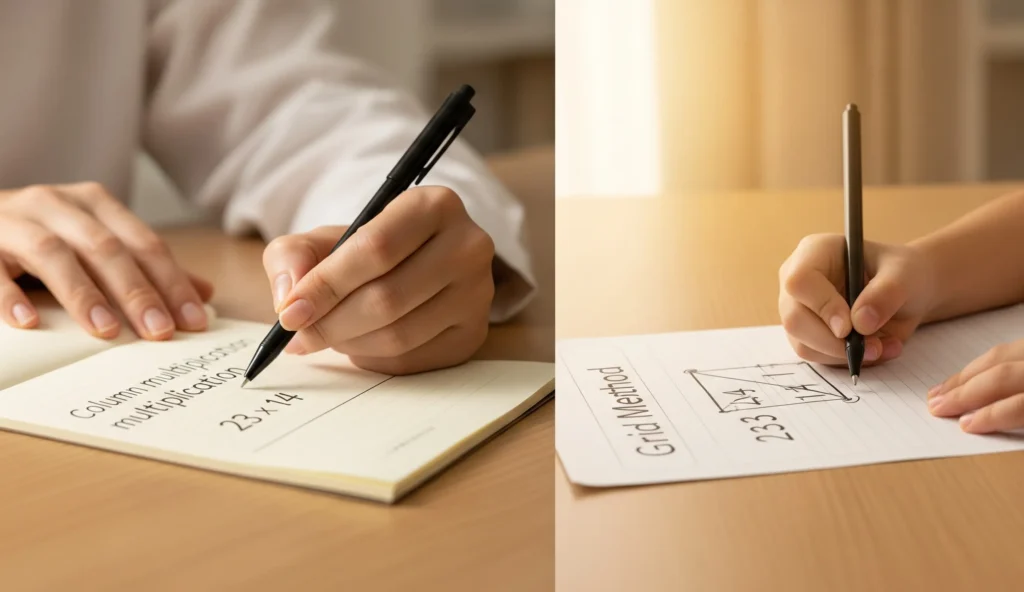A Parent's Guide to the 'New' Maths: Understanding Modern Primary Teaching Methods
You lean over your child’s shoulder to help with their maths homework, and you see something that stops you in your tracks. To solve a simple multiplication like 24 x 6, they are drawing a grid. To solve a subtraction, they are hopping along a line. You know the answer is 144, you can do it in your head, but the method on the page is completely alien.
If you’ve ever felt this wave of confusion, or thought, “Why don’t they just teach it the ‘normal’ way?”, you are part of a very large club.

The way primary maths is taught today in many Dubai schools has fundamentally shifted. The focus has moved away from pure rote memorization of procedures (like carrying and borrowing) towards building a deep, intuitive number sense. The goal is no longer just for children to get the right answer, but for them to understand why the answer is right.
This guide is here to be your friendly translator. We’ll demystify three of the most common “new” methods—partitioning, the grid method, and number lines—so you can feel confident helping your child and appreciate the powerful logic behind them.
1. The Partitioning Method (for Addition & Subtraction)
This is often the first method that looks different. Partitioning simply means breaking numbers down into their place value components (hundreds, tens, and ones).
Example Addition Problem: 45 + 32
Instead of the traditional column method, a child will:
Partition the numbers: 45 becomes (40 + 5) and 32 becomes (30 + 2).
Add the tens: 40 + 30 = 70.
Add the ones: 5 + 2 = 7.
Combine the results: 70 + 7 = 77.
Why it works: This method forces children to see the numbers for their true value (a ‘4’ in the tens column is ’40’), building a much stronger foundation of place value.
2. The Grid Method (for Multiplication)
This is the one that surprises parents the most. It’s a visual way to multiply larger numbers without getting lost in “carrying.”
Example Multiplication Problem: 24 x 6
Draw a grid: A simple 2×1 grid in this case.
Partition the larger number: 24 is partitioned into 20 and 4. These numbers go along the top of the grid. The number you are multiplying by (6) goes down the side.
Multiply each box:
20 x 6 = 120
4 x 6 = 24
Add the results:
120 + 24 = 144
Why it works: It breaks down a daunting multiplication into smaller, manageable “chunks.” It’s visually organized and ensures that no part of the calculation is forgotten, which is a common issue with the traditional column method.
3. The Number Line Method (for Subtraction)
Instead of “borrowing from next door,” the number line method builds a powerful understanding of subtraction as finding the difference between two numbers.
Example Subtraction Problem: 81 – 57
Draw a number line: Place the smaller number (57) on the left and the larger number (81) on the right.
“Jump” to a friendly number: Start at 57 and “jump” to the next easy ten, which is 60. The size of this jump is 3.
Make a big jump: Now, jump from 60 all the way to 80. The size of this jump is 20.
Make the final small jump: Jump from 80 to 81. The size of this jump is 1.
Add up the jumps: The total difference is the sum of your jumps: 3 + 20 + 1 = 24. So, 81 – 57 = 24.
Why it works: This is how many people naturally calculate change in their head! It builds mental math skills and reinforces the idea that subtraction is about finding the distance between two points. While it may seem long-winded at first, for many children, this visual journey is far more intuitive than the abstract rules of borrowing.
Why Teach This Way? The Long-Term Benefit
The goal of these modern methods is to build mathematical flexibility. By understanding how numbers can be taken apart and put back together, children become confident problem-solvers. They develop a deeper number sense that prepares them for more complex topics like algebra, instead of just memorizing a single, rigid procedure that they don’t fully understand.
It can be a difficult adjustment for both children and parents. If you find that these visual methods aren’t “clicking” for your child, it might be a sign they need a little extra help to build their core conceptual understanding. The personalized, one-on-one approach of a primary maths tutor in Dubai can be incredibly effective at bridging this gap.
An expert tutor can use manipulatives and targeted strategies to make these abstract ideas concrete, ensuring your child doesn’t just learn the how but masters the why. For parents who feel lost, having a specialist primary school tutor on their team can be a huge relief, providing a clear and consistent approach to support their child’s learning.
Conclusion: Partners in a New Way of Learning
It’s completely normal to feel like your child is learning a different language when it comes to maths. The key is to approach it with curiosity. By understanding the “why” behind these new methods, you can become a more confident and effective partner in your child’s education. Celebrate their thinking process, not just their ability to get the right answer, and you’ll be nurturing a resilient and powerful young mathematician.
If you’re ready to provide your child with the personalized support they need to thrive with modern maths, learn more about our primary tutoring programs.